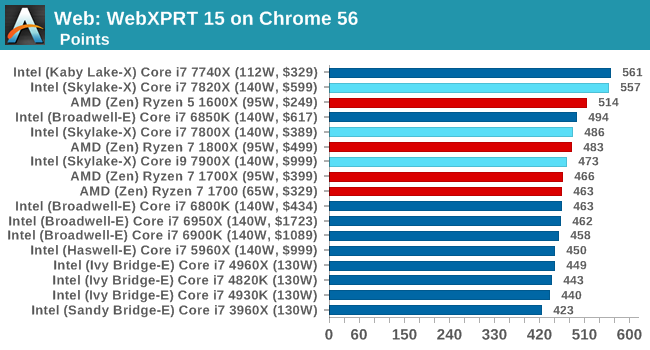The Intel Skylake-X Review: Core i9 7900X, i7 7820X and i7 7800X Tested
by Ian Cutress on June 19, 2017 9:01 AM ESTBenchmarking Performance: CPU Web Tests
One of the issues when running web-based tests is the nature of modern browsers to automatically install updates. This means any sustained period of benchmarking will invariably fall foul of the 'it's updated beyond the state of comparison' rule, especially when browsers will update if you give them half a second to think about it. Despite this, we were able to find a series of commands to create an un-updatable version of Chrome 56 for our 2017 test suite. While this means we might not be on the bleeding edge of the latest browser, it makes the scores between CPUs comparable.
SunSpider 1.0.2
The oldest web-based benchmark in this portion of our test is SunSpider. This is a very basic javascript algorithm tool, and ends up being more a measure of IPC and latency than anything else, with most high-performance CPUs scoring around about the same. The basic test is looped 10 times and the average taken. We run the basic test 4 times.

Sunspider goes after peak frequency most of the time, althoguh there is some variation as it moves into basically becoming a legacy test.
Mozilla Kraken 1.1
Kraken is another Javascript based benchmark, using the same test harness as SunSpider, but focusing on more stringent real-world use cases and libraries, such as audio processing and image filters. Again, the basic test is looped ten times, and we run the basic test four times.

Kraken is more of an intense attack on JS, and still regularly sorts by IPC and frequency.
Google Octane 2.0
Along with Mozilla, as Google is a major browser developer, having peak JS performance is typically a critical asset when comparing against the other OS developers. In the same way that SunSpider is a very early JS benchmark, and Kraken is a bit newer, Octane aims to be more relevant to real workloads, especially in power constrained devices such as smartphones and tablets.

Octane seems to be an optimization target, and with the new Skylake-X it shows.
WebXPRT 2015
While the previous three benchmarks do calculations in the background and represent a score, WebXPRT is designed to be a better interpretation of visual workloads that a professional user might have, such as browser based applications, graphing, image editing, sort/analysis, scientific analysis and financial tools.











264 Comments
View All Comments
Ian Cutress - Monday, June 19, 2017 - link
Prime95AnandTechReader2017 - Tuesday, June 20, 2017 - link
Are you sure the numbers are correct as the i7 6950X on your graph here states less than the 135W on your original review of it under an all-core load.Ian Cutress - Tuesday, June 20, 2017 - link
We're running a new test suite, different OSes, updated BIOSes, with different metrics/data gathering (might even be a different CPU, as each one is slightly different). There's going to be some differences, unfortunately.gerz1219 - Monday, June 19, 2017 - link
Power draw isn't relevant in this space. High-end users who work from a home office can write off part of their electric bill as a business expense. Price/performance isn't even that much of an issue for many users in this space for the same reason -- if you're using the machine to earn a living, a faster machine pays for itself after a matter of weeks. The only thing that matters is performance. I don't understand why so many gamers read reviews for non-gamer parts and apply gamer complaints.demMind - Monday, June 19, 2017 - link
This kind of response keeps popping up and is highly short sighted. Price for performance matters to high end especially if you use it for your livelihood.If you go large-scale movie rendering studios will definitely be going with what can soften the blow to a large scale project. This is a fud response.
Spunjji - Tuesday, June 20, 2017 - link
Power efficiency will matter again when Intel lead in it. Been watching the same see-saw on the graphics side with nVidia. They lead in it now, so now it's the most important factor.Marketing works, folks.
JKflipflop98 - Thursday, June 22, 2017 - link
Ah, AMD fanbots. Always with the insane conspiracy theories.AnandTechReader2017 - Tuesday, June 20, 2017 - link
Power draw is important as well as temps, it will allow you to push to higher clocks and cut costs.Say your work had to get 500 of these machines, if you can use a cheaper PSU, cheaper CPU and lower power use, the saving could be quite extreme. We're talking 95W vs 140W, a 50% increase versus the Ryzen. That's quite a bit in the long run.
I run 4 high-end desktops in my household, the power draw saving would be quite advantageous form me. All depends on circumstances, information is king.
Ian posted that everything is running at stock speeds, each version overclocked with power draw would also be interesting, also the difference different RAM clock speeds make (there was a huge fiasco with people claiming nice performance increases by using higher RAM clocks with the Ryzen CPU, how much is Intel's new line-up influenced? Can we cut costs and spend more on GPU/monitor/keyboard/pretty much anything else?)
psychok9 - Sunday, July 23, 2017 - link
It's scandalous... no one graph about temperature!? I suspect that if it had been an AMD cpu we would have mass hysteria and daily news... >:(I'm looking for Iy 7820X and understand how can I manage with an AIO.
cknobman - Monday, June 19, 2017 - link
Nope this CPU is a turd IMO.Intel cheaped out on thermal paste again and this chip heats up big time.
Only 44PCIE lanes, shoddy performance, and a rushed launch.
Only a sucker would buy now before seeing AMD Threadripper and that is exactly why, and who, Intel released these things so quickly for.